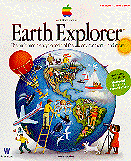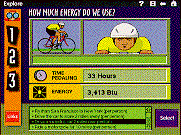


|
Earth Explorer.
Apple Home Learning.
Claris Canada, 1995. CD-ROM, $49.00.
Grades 5 - 8 / Ages 10-12.
Review by Harriet Zaidman.
***/4
|
CD-ROMs are the wave of the future, we're told, and
information is being formatted on compact disk at a
fantastic rate. It's being presented in user-friendly
formats, with several different ways of finding information,
links back and forth, titbits of explanations, pictures and
captions, quizzes and games, just to mention a few. Some of
these CD's are for school use, and some are informational,
but are more suited for recreational (home) use.

Earth Explorer is a highly informative and interactive
CD-ROM published by Apple, respected for quality educational
software. A 256-colour monitor is necessary. For a Mac
you'll also need at least five megs of RAM; for Windows, a
486 system or better is recommended (it will run more slowly
on a 386) and at least four megs of RAM (eight is
recommended).
The CD explores the environment, with articles, ``hot
topics," maps, data, games and quizzes. Each topic leads to
further subtopics. The buttons that lead into the
information are described as well as illustratedwith
appealing drawings that relate to the topic of the
environment and are age-appropriate.
The user chooses the topic, and begins to explore the
different issues and problems facing the earth. The articles
(choose from climate, sun, wind, climate change, water,
oceans, land, micro-climate, or explore) are accompanied
with pictures and links on the right sidebar. The articles
provide extensive information, often over twenty screens in
length. Each screen is presented as a page torn from a
book. Significant words are underlined; clicking on them
brings up a definition. The File menu allows the user to
print the screen or print the article, and the option of
including the photos. The writing style is casual and
conversational. Here's an example:
Here's a challenge for you.
Think of something that runs on
solar energy. Piece of cake, you might say, and you start
naming items that use the sun as their energy source.
There's the calculator on your desktop, and the small
electric fan you saw in a specialty store. There's the house
down the street that heats water with solar energy, those
experimental cares they race every three years in Australia
. . . and what about earth-orbiting satellites?
 The ``Hot Topics" provides eighteen different subtopics for
the user. Each button leads to a game. The games are talking
stories, in which the user must match different sides of an
environmental issue with the sixteen different personalities
presented. The goal is to match the personalities with the
strongest views on each side of the argument to score the
highest number of points. Each personality reveals their
views before players attempt to match them to either side of
the argument. A click on the score button tells the user
what to do to improve it, and users can go back and continue
working on the same game.
The ``Hot Topics" provides eighteen different subtopics for
the user. Each button leads to a game. The games are talking
stories, in which the user must match different sides of an
environmental issue with the sixteen different personalities
presented. The goal is to match the personalities with the
strongest views on each side of the argument to score the
highest number of points. Each personality reveals their
views before players attempt to match them to either side of
the argument. A click on the score button tells the user
what to do to improve it, and users can go back and continue
working on the same game.
The Data Sets includes eighteen subtopics, with maps and
graphs on each. Explanatory text boxes appear at the bottom
of the screen that complement the variety of graphs offered
on the right of the map. Click at an area on the map and the
appropriate information appears in the text box.
Instructions appear for interpreting the graph and for
retrieving further information.

The Explore menu offers twelve subtopics that are
informational games/quizzes. One is called ``Who Eats Who,"
and asks the user to organize different aquatic animals
according to their order on the food chain. Again, the user
can check the score and go back to get things right.
Information about the different animals is provided. The
numbers 1, 2 and 3 decorate the left side-bar. Clicking on
the different numbers gives instructions (1), hints on what
to notice in the game (2) and the conclusions that can be
drawn from the investigation (3).
This CD-ROM is full of interesting information about the
issues facing the earth's survival and about the different
arguments surrounding these issues, and presents scientific
information valuable for the intended age-group. Earth
Explorer is not appropriate, however, for a school library
reference, because as a reference tool it is slower than
comparable disk-based encyclopedias. But it would be
suitable as a supplement to reference material within the
classroom, especially if the class is studying a unit on
pollution, the ecology, and so forth. Earth Explorer is also
an appropriate educational resource for the home. Parents
looking for educational material for young children can
trust that Apple will provide them with value for their
money.
The problems with this CD-ROM are the same problems that
exist for education CD-ROMs in general. The more complex
they are the slower they are, and the wait is boring, not
exciting. It's faster to turn a few pages, browse through an
index, and look at some pictures on a book -- and flipping
through a book is actually a more ``interactive" experience,
since one can stop and read at any page. The delay in
finding information may cause a child to give up and go
away.
Are children using the educational home software as fast as
it is being produced? Probably not, despite their parents'
best wishes. After the novelty has worn off, it will be used
when it is needed. When it is, Earth Explorer is a useful CD
for intermediate age children.
Recommended.
Harriet Zaidman is a teacher-librarian in Winnipeg.
To comment on this title or this review, send mail to cmeditor@mts.net.

Copyright © 1996 the Manitoba Library Association.
Reproduction for personal use is permitted only if this copyright notice
is maintained. Any other reproduction is prohibited without permission.
Published by
The Manitoba Library Association
ISSN 1201-9364

CONTENTS FOR THIS ISSUE |
WELCOME


![]()




![]()
![]()